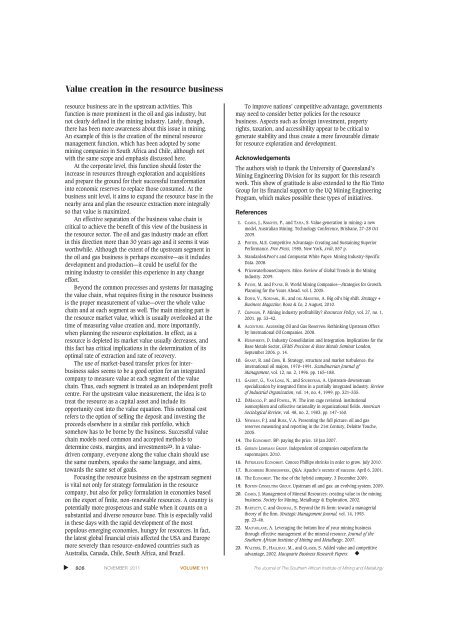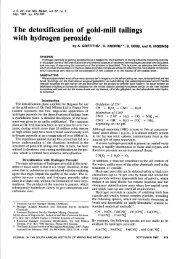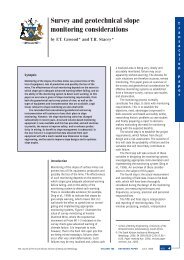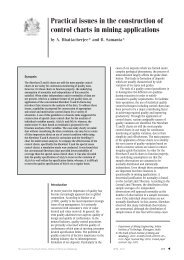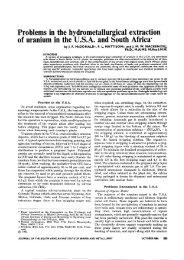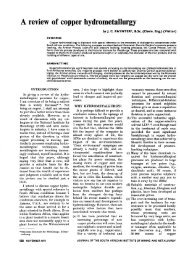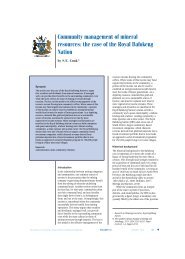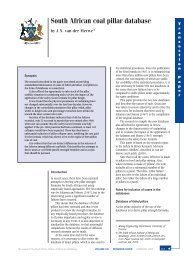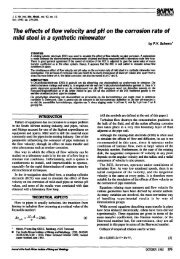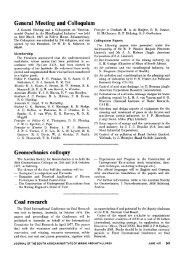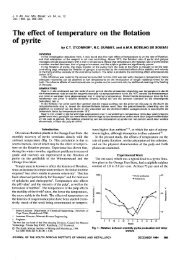Investigation of factors influencing the determination of ... - saimm
Investigation of factors influencing the determination of ... - saimm
Investigation of factors influencing the determination of ... - saimm
You also want an ePaper? Increase the reach of your titles
YUMPU automatically turns print PDFs into web optimized ePapers that Google loves.
Value creation in <strong>the</strong> resource business<br />
resource business are in <strong>the</strong> upstream activities. This<br />
function is more prominent in <strong>the</strong> oil and gas industry, but<br />
not clearly defined in <strong>the</strong> mining industry. Lately, though,<br />
<strong>the</strong>re has been more awareness about this issue in mining.<br />
An example <strong>of</strong> this is <strong>the</strong> creation <strong>of</strong> <strong>the</strong> mineral resource<br />
management function, which has been adopted by some<br />
mining companies in South Africa and Chile, although not<br />
with <strong>the</strong> same scope and emphasis discussed here.<br />
At <strong>the</strong> corporate level, this function should foster <strong>the</strong><br />
increase in resources through exploration and acquisitions<br />
and prepare <strong>the</strong> ground for <strong>the</strong>ir successful transformation<br />
into economic reserves to replace those consumed. At <strong>the</strong><br />
business unit level, it aims to expand <strong>the</strong> resource base in <strong>the</strong><br />
nearby area and plan <strong>the</strong> resource extraction more integrally<br />
so that value is maximized.<br />
An effective separation <strong>of</strong> <strong>the</strong> business value chain is<br />
critical to achieve <strong>the</strong> benefit <strong>of</strong> this view <strong>of</strong> <strong>the</strong> business in<br />
<strong>the</strong> resource sector. The oil and gas industry made an effort<br />
in this direction more than 30 years ago and it seems it was<br />
worthwhile. Although <strong>the</strong> extent <strong>of</strong> <strong>the</strong> upstream segment in<br />
<strong>the</strong> oil and gas business is perhaps excessive—as it includes<br />
development and production—it could be useful for <strong>the</strong><br />
mining industry to consider this experience in any change<br />
effort.<br />
Beyond <strong>the</strong> common processes and systems for managing<br />
<strong>the</strong> value chain, what requires fixing in <strong>the</strong> resource business<br />
is <strong>the</strong> proper measurement <strong>of</strong> value—over <strong>the</strong> whole value<br />
chain and at each segment as well. The main missing part is<br />
<strong>the</strong> resource market value, which is usually overlooked at <strong>the</strong><br />
time <strong>of</strong> measuring value creation and, more importantly,<br />
when planning <strong>the</strong> resource exploitation. In effect, as a<br />
resource is depleted its market value usually decreases, and<br />
this fact has critical implications in <strong>the</strong> <strong>determination</strong> <strong>of</strong> its<br />
optimal rate <strong>of</strong> extraction and rate <strong>of</strong> recovery.<br />
The use <strong>of</strong> market-based transfer prices for interbusiness<br />
sales seems to be a good option for an integrated<br />
company to measure value at each segment <strong>of</strong> <strong>the</strong> value<br />
chain. Thus, each segment is treated as an independent pr<strong>of</strong>it<br />
centre. For <strong>the</strong> upstream value measurement, <strong>the</strong> idea is to<br />
treat <strong>the</strong> resource as a capital asset and include its<br />
opportunity cost into <strong>the</strong> value equation. This notional cost<br />
refers to <strong>the</strong> option <strong>of</strong> selling <strong>the</strong> deposit and investing <strong>the</strong><br />
proceeds elsewhere in a similar risk portfolio, which<br />
somehow has to be borne by <strong>the</strong> business. Successful value<br />
chain models need common and accepted methods to<br />
determine costs, margins, and investments23. In a valuedriven<br />
company, everyone along <strong>the</strong> value chain should use<br />
<strong>the</strong> same numbers, speaks <strong>the</strong> same language, and aims,<br />
towards <strong>the</strong> same set <strong>of</strong> goals.<br />
Focusing <strong>the</strong> resource business on <strong>the</strong> upstream segment<br />
is vital not only for strategy formulation in <strong>the</strong> resource<br />
company, but also for policy formulation in economies based<br />
on <strong>the</strong> export <strong>of</strong> finite, non-renewable resources. A country is<br />
potentially more prosperous and stable when it counts on a<br />
substantial and diverse resource base. This is especially valid<br />
in <strong>the</strong>se days with <strong>the</strong> rapid development <strong>of</strong> <strong>the</strong> most<br />
populous emerging economies, hungry for resources. In fact,<br />
<strong>the</strong> latest global financial crisis affected <strong>the</strong> USA and Europe<br />
more severely than resource-endowed countries such as<br />
Australia, Canada, Chile, South Africa, and Brazil.<br />
To improve nations’ competitive advantage, governments<br />
may need to consider better policies for <strong>the</strong> resource<br />
business. Aspects such as foreign investment, property<br />
rights, taxation, and accessibility appear to be critical to<br />
generate stability and thus create a more favourable climate<br />
for resource exploration and development.<br />
Acknowledgements<br />
The authors wish to thank <strong>the</strong> University <strong>of</strong> Queensland’s<br />
Mining Engineering Division for its support for this research<br />
work. This show <strong>of</strong> gratitude is also extended to <strong>the</strong> Rio Tinto<br />
Group for its financial support to <strong>the</strong> UQ Mining Engineering<br />
Program, which makes possible <strong>the</strong>se types <strong>of</strong> initiatives.<br />
References<br />
1. CAMUS, J., KNIGHTS, P., and TAPIA, S. Value generation in mining: a new<br />
model, Australian Mining. Technology Conference, Brisbane, 27–28 Oct<br />
2009.<br />
2. PORTER, M.E. Competitive Advantage: Creating and Sustaining Superior<br />
Performance. Free Press, 1985, New York, xviii, 557 p.<br />
3. Standards&Poor’s and Compustat White Paper: Mining Industry-Specific<br />
Data. 2008.<br />
4. PricewaterhouseCoopers. Mine. Review <strong>of</strong> Global Trends in <strong>the</strong> Mining<br />
Industry. 2009.<br />
5. PAYNE, M. and PAYNE, B. World Mining Companies—Strategies for Growth.<br />
Planning for <strong>the</strong> Years Ahead. vol. I, 2005.<br />
6. DOSHI, V., NORDAHL, H., and DEL MAESTRO, A. Big oil’s big shift. Strategy +<br />
Business Magazine, Booz & Co, 2 August, 2010.<br />
7. CROWSON, P. Mining industry pr<strong>of</strong>itability? Resources Policy, vol. 27, no. 1,<br />
2001. pp. 33–42.<br />
8. ACCENTURE. Accessing Oil and Gas Reserves: Rethinking Upstream Offers<br />
by International Oil Companies. 2008.<br />
9. HUMPHREYS, D. Industry Consolidation and Integration: Implications for <strong>the</strong><br />
Base Metals Sector, GFMS Precious & Base Metals Seminar London,<br />
September 2006. p. 14.<br />
10. GRANT, R. and CIBIN, R. Strategy, structure and market turbulence: <strong>the</strong><br />
international oil majors, 1970–1991. Scandinavian Journal <strong>of</strong><br />
Management, vol. 12, no. 2, 1996. pp. 165–188.<br />
11. GAUDET, G., VAN LONG, N., and SOUBEYRAN, A. Upstream-downstream<br />
specialization by integrated firms in a partially integrated industry. Review<br />
<strong>of</strong> Industrial Organization, vol. 14, no. 4, 1999. pp. 321–335.<br />
12. DIMAGGIO, P. and POWELL, W. The iron cage revisited: institutional<br />
isomorphism and collective rationality in organizational fields. American<br />
Sociological Review, vol. 48, no. 2, 1983. pp. 147–160.<br />
13. NEWMAN, P.J. and BURK, V.A. Presenting <strong>the</strong> full picture: oil and gas<br />
reserves measuring and reporting in <strong>the</strong> 21st Century, Deloitte Touche,<br />
2005.<br />
14. The ECONOMIST. BP: paying <strong>the</strong> price. 18 Jan 2007.<br />
15. GERSON LEHRMAN GROUP. Independent oil companies outperform <strong>the</strong><br />
supermajors. 2010.<br />
16. PETROLEUM ECONOMIST. Conoco Phillips shrinks in order to grow. July 2010.<br />
17. BLOOMBERG BUSINESSWEEK, Q&A: Apache’s secrets <strong>of</strong> success. April 6, 2001.<br />
18. The ECONOMIST. The rise <strong>of</strong> <strong>the</strong> hybrid company. 3 December 2009.<br />
19. BOSTON CONSULTING GROUP, Upstream oil and gas: an evolving system. 2009.<br />
20. CAMUS, J. Management <strong>of</strong> Mineral Resources: creating value in <strong>the</strong> mining<br />
business. Society for Mining, Metallurgy & Exploration, 2002.<br />
21. BARTLETT, C. and GHOSHAL, S. Beyond <strong>the</strong> M-form: toward a managerial<br />
<strong>the</strong>ory <strong>of</strong> <strong>the</strong> firm. Strategic Management Journal, vol. 14, 1993.<br />
pp. 23–46.<br />
22. MACFARLANE, A. Leveraging <strong>the</strong> bottom line <strong>of</strong> your mining business<br />
through effective management <strong>of</strong> <strong>the</strong> mineral resource. Journal <strong>of</strong> <strong>the</strong><br />
Sou<strong>the</strong>rn African Institute <strong>of</strong> Mining and Metallurgy, 2007.<br />
23. WALTERS, D., HALLIDAY, M., and GLASER, S. Added value and competitive<br />
advantage, 2002. Macquarie Business Research Papers. ◆<br />
▲<br />
808 NOVEMBER 2011 VOLUME 111 The Journal <strong>of</strong> The Sou<strong>the</strong>rn African Institute <strong>of</strong> Mining and Metallurgy


